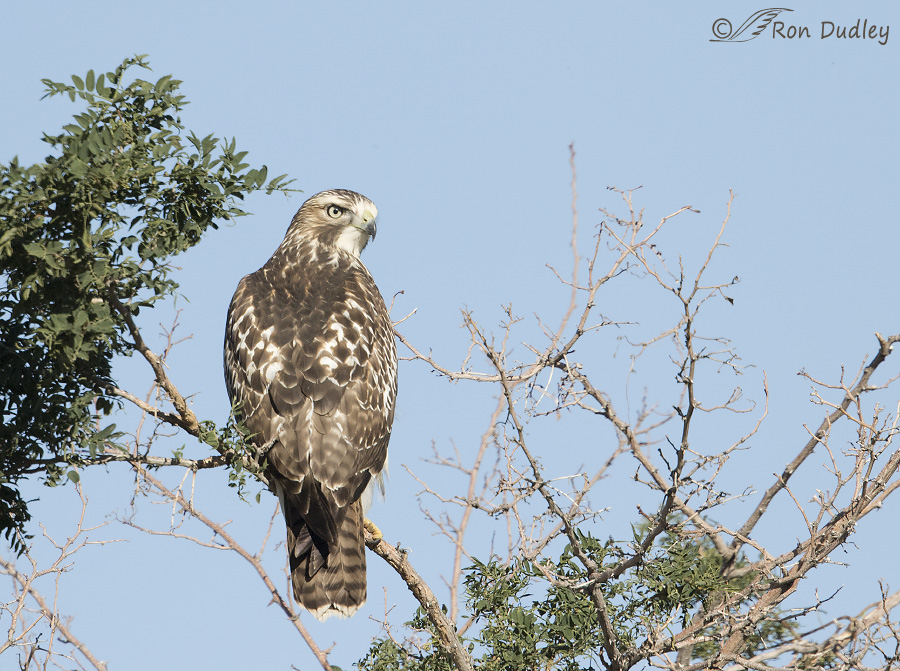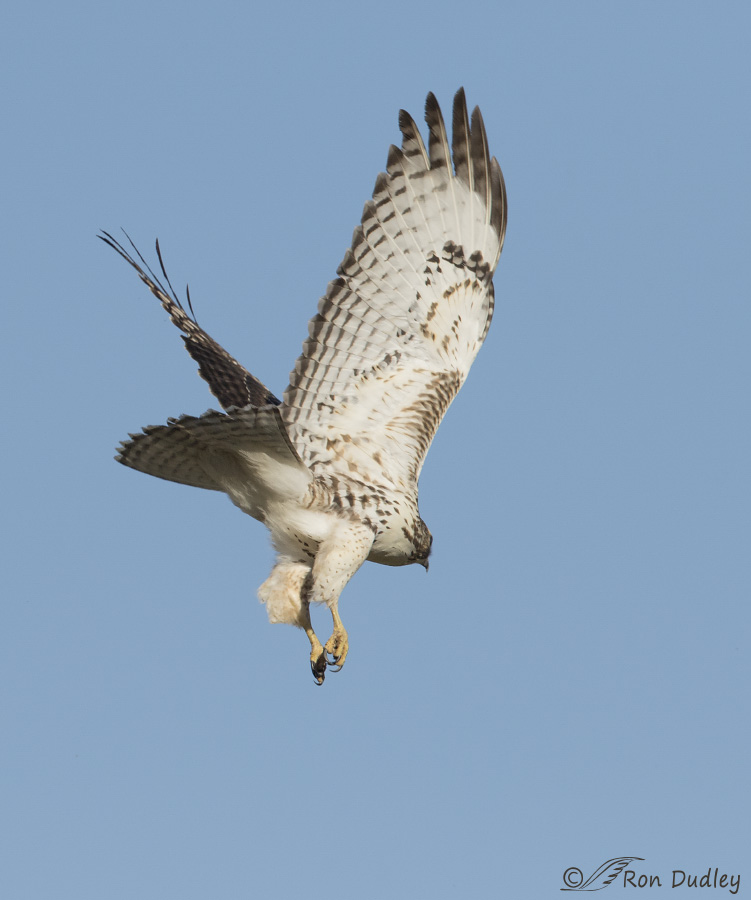I don’t believe I’ve ever photographed an Eastern Red-tailed Hawk before so this bird caught my attention.
 1/2500, f/6.3, ISO 500, Canon 7D Mark II, Canon EF500mm f/4L IS II USM +1.4 tc, not baited, set up or called in
1/2500, f/6.3, ISO 500, Canon 7D Mark II, Canon EF500mm f/4L IS II USM +1.4 tc, not baited, set up or called in
I photographed it two days ago at Farmington Bay WMA. While I was looking at it through my lens I was struck by its overall light color and especially the whites on the head and back. For an instant the white forehead and throat reminded me of many Swainson’s Hawks.
A little research the next day made me think it’s an Eastern light morph Red-tailed Hawk (Buteo jamaicensis borealis) but the Red-tailed Hawk is the most variably plumaged raptor species in North America and eastern birds are uncommon west of the Rockies (where I am here in Salt Lake City). Throw in the fact that I’m far from a raptor ID expert and I certainly can’t make the claim that it’s an eastern red-tail absolutely. But as of now I’m thinking that it’s likely.

1/3200, f/6.3, ISO 500, Canon 7D Mark II, Canon EF500mm f/4L IS II USM, not baited, set up or called in
While perched the hawk never did turn and face me and when it took off it did so mostly away from me so this is the best look I got at the front of the bird. If anyone out there has an opinion on the subspecies of this hawk I’d love to hear it, though I realize that knowing with absolute certainty may be impossible due to overlap in range and plumage.
Either way I thought it was a beautiful and striking juvenile red-tail.
Ron


Gorgeous bird Ron, and great captures 😉 If you are interested, I have quite a library of juvenile RTHA images on my Flickr site–you’ll find 3 albums (2013-15) of Cornell RTHAs in all sorts of poses to make any comparisons you care to–looks like the consensus is you did find an Eastern bird visiting your area! Here is the link: https://www.flickr.com/photos/christinebphotos/albums/with/72157635526783881
Yes Ron, looks good for an Eastern. Thanks for sharing the pics!
Good to know, Jerry. Thank you.
The bird caught your attention – but the first shot clearly shows that is was mutual. You were in its gaze…
Love that second shot too (of course).
I figured you might see something in that second image that you liked, EC…
Wonderful Ron!
Charlotte
Thanks, Charlotte.
Hi Ron,
You can get a pretty fast (and expert) ID by posting on the “Hawk ID” Facebook group. Red-tailed subspecies are right up their alley! More importantly,this is a beautiful image of a beautiful bird! Thanks, as always, for sharing!
Cheers,
Dick
I hadn’t thought of that possibility, Dick. Thanks for the suggestion. And I agree, it’s a great looking bird.
Looks like an eastern one to me, which is what I cut my raptor teeth on, so to speak. It would explain why I have a hard time recognizing our Western Red Tails as Red Tails… I’m used to seeing that light color. The one thing I question about this ID, though, is the barred tail. The juvenile we’ve been watching this year has a solid white tail, and all the eastern Red Tails I’ve seen have been adults with solid red tails. I’ve never seen a barred tail on a Red Tail… That sent me to my Crossley guide, and it does indeed show a barred tail on the eastern RTHA. I think you nailed the ID.
“I think you nailed the ID.”
I hope so, Susan. Thanks for the feedback on your eastern birds.
Susan,
I believe there are populations of red-tails that breed in the northern plains and Alaska and have partially white tails (Krider’s & Harlans’s). Are you in the Texas panhandle?
The rescue I fostered in KY was 22″ long and grew to have an all white adult tail but an unusable wing due to a frustrated hunter’s pot-shots. Her length was much bigger than listed in Sibley and in the Golden Guide I was using; so, I measured her alive several times. I did not measure her dead. National Geographics Field Guide to Birds has 22″ length. It also lists intergrade zones between sspp. calurus, harlani, krideri and fuertesi in the western US. I don’t see an illustration of ssp. fuertesi in any of my guides; so, I don’t know the tail colors of juveniles or adults.
Boudiciea’s tail color might have been lighter than a hawk taking wild food. She got meat mostly from domestic rabbit, wild boar, and house and deer mice (the cat caught) to eat with a bit of deer and beef and road kill. There were no birds, amphibians or reptiles in her diet.
Pam, I live in El Paso, TX – about as far west as one can get in Texas. I’ve been learning a lot about Red Tails lately because of the juvenile we have hanging around at Hueco Tanks State Park & Historic Site (as volunteers we spend a lot of time out there). I saw it sitting in a tree the other day when we were leaving the park, was able to get some pictures of it, and in the end discovered that it was the RTHA once again. These birds are amazingly variable, so I’m glad there are good guide books out there to help us. I just looked at my Sibley guide and was surprised to see how dark even the light morph western ones are compared to what I remember of the eastern ones. I’m pretty sure I’ve never seen any of the subspecies. It’s interesting what you said about your rescue bird possibly having lighter coloration because of not eating wild food. That made a lot of sense to me, knowing that the coloration of birds like Flamingoes is dependent on their diet.
I looks like the lighter ones we commonly have in Wisconsin. The usual lighter diagonal strips along its “shoulders” make the local juvenile red-tails easy to ID from perched large hawks.
I hope to see comments from one of the hawk experts.
Hopefully we’ll find out for sure, Pam.
I especially liked the second shot, in that such a clear look at both the leggings and the underwing together is something I haven’t had opportunity to see in such clarity–thanks for EVERY DAY !
“thanks for EVERY DAY!”
I’m glad you appreciate the daily posts, Kris. Thanks.
What a beautiful bird, whatever it is…I’ve never seen one like it…hope someone can verify its identity…would like to see more of it….has Jerry seen this?
Thanks, Patty. Jerry’s been pretty busy at the Hawkwatch site on Goshute Mountain so I don’t know if he’ll be able to weigh in or not.
Beautiful, but then I don’t think there is such a thing as an ugly raptor 😉 The whole idea of the various subspecies is fraught with opportunities to misidentify. I usually decline to get into the discussion and let others decide while I gaze at the wonder of their beauty.
That’s what I usually do too, Laura. But this one just kept nagging at me so I decided to pursue it as best I could.